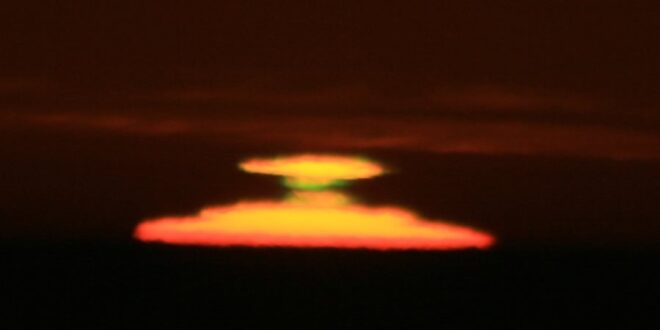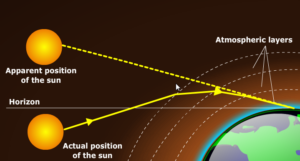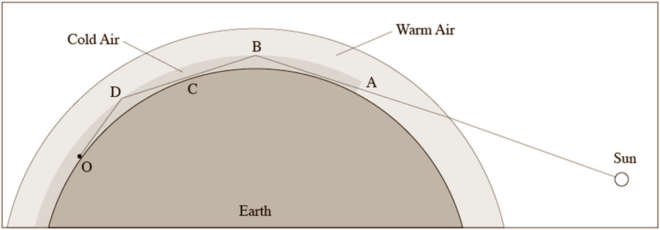
Refraction Explained


Complexity in Calculating Refraction
Since the amount of refraction depends on the pressure (the denser the atmosphere is, the greater the refraction), temperature (hot air is less dense and refracts less) and to a lesser degree humidity (water vapor in the air impacts the refraction) in each layer of the atmosphere, calculating refraction is complex and requires very detailed meteorological information on the current conditions in each layer of the atmosphere in the area being computed. This can’t be done accurately in advance, and even calculations for the current day require readings from weather balloons at multiple elevations for accurate measurement, something not very practical (though the BMG Lakewood vasikin minyan and likely other minyanim as well) manually adjust the hanetz hachama time each morning based on the weather). For this reason, zmanim (as well as civil sunrise and sunset) calculations usually use a global average refraction of 34′ of a degree, or 0.5666°. The global average atmospheric refraction accounts for sunrise being between 3:01 minutes earlier (during the solstice), and 2:29 minutes earlier (during the equinox) in Yerushalayim, as opposed to the value in a vacuum (the difference depends on where in the world you are, in Lakewood, NJ the range is 3:29 – 2:57). This average atmospheric refraction is not very accurate but is commonly used since it is complex to calculate local averages. More accurate refraction figures can be calculated for local and seasonal atmospheric models, and these have been shown to be accurate to within 15 seconds 90% of the time in the case of summer and winter subtropical models used in a study in Israel. See Using a Digital Terrain Model to Calculate Visual Sunrise and Sunset Times by Rabbi Chaim Keller and Dr. John K. Hall for additional details.
Inversion and the Novaya Zemlya Effect
Under usual conditions, the atmosphere gets colder at elevation, with the warmest air being closest to earth. An inversion condition is where there is a layer of cold air under a layer of warmer air. When there is an inversion over a large area (greater than 400 km), the solar rays get ducted in the lower colder air layer (see image below) and produce an extreme refraction. This is known as the Novaya Zemlya effect and produces a solar mirage resulting in the somewhat visually distorted sun being visible much earlier than expected (see top image).
On rare occasions, the Sun appeared to rise much earlier or set much later than predicted by such publications as the Tables of Sunrise, Sunset, and Twilight (USNO 1962). In our study, the sunrise of 1991 January 10 was almost 12 minutes early. This phenomenon is known as the Novaya Zemlya solar mirage (Lehn 1979). It appears to be caused by a geographically extensive temperature inversion within the boundary layer of the atmosphere. The resulting vertical density profile causes the sunlight to be ducted around the curvature of the Earth. For the purpose of this study, we defined anomalously large astronomical refraction to be an event with refraction greater than 1°. A total of 12 anomalous events were recorded (2.9%).
While these typically occur in cold areas, they can happen in other areas as well. The study authors mention that
The majority of the anomalous events took place in the cold months. Nine of the 12 events occurred between November 1 and April 30, with January having five events. At the time of the events, the average surface temperature was -10.9°C, and all events occurred with surface-inversion conditions. Surface inversions tend to form with overnight surface radiative cooling through a dry atmosphere. Typically, they persist into the early morning, even after sunrise. Even though most of the events took place in the cold parts of the year, the data suggest that the Novaya Zemlya solar mirage may not be an exclusively cold-weather or polar phenomenon. Four of the events occurred with a surface temperature greater than 0°C. One event took place 2 days after the summer solstice.
Refraction at Sunrise VS Sunset
The University of Calgary study found that extreme refraction is an order of magnitude more common at sunrise than sunset. The reason for the difference between sunrise and sunset is that
This may be because the lower atmosphere is better mixed during the day as a result of solar heating leading to a dry adiabatic lapse rate in the boundary layer. Anomalously large astronomical refraction events the “Novaya Zemlya solar mirage” occurred about 3% of the time and were an order of magnitude more common at sunrise than sunset.
That said, The Novaya Zemlya effect does occur at sunset and in warm climates as seen in this video of sunset in San Francisco. Sadly, the video does not include information on how long it delayed sunset.
Halacha
Halachically sunrise and sunset times depend on when we can see the sun, and not when it is at the horizon. As mentioned above, the average global refraction of 34′ results in sunrise appearing about 3 minutes earlier and sunset 3 minutes later than in a vacuum, and this refraction (or other similar refraction values) is what is used in all calendars (both halachic and civil). The fact that there is such potential for variation in weather conditions, and that the global average is likely not what is present where the zmanim are being calculated, is the reason that many luchos (zmanim calendars) have disclaimers about accuracy. Many calendars round off their zmanim without showing seconds due to the inability to accurately calculate zmanim because of refraction variations. Lahalacha the impact of earlier or later sunrise is limited to vasikin minyanim. A separate article may be needed to actually discuss sof zman krias shema and other zmanim‘s relation to sunrise and sunset VS the actual position of the sun in the sky (1/4 of the way across its path for sof zman krias shema). The halachic impact of refraction at sunset is much greater since it impacts the day/night boundary, but those are much rarer.
Now to the big question, does extreme refraction such as the Novaya Zemlya effect impact zmanim? The fact that it rarely impacts sunset, means that it almost academic since predicting the inversion before a vasikin minyan starts is impractical. In a conversation with one posek a number of years ago, he felt that the Novaya Zemlya Effect should not impact zmanim lahalacha due to the fact that unusual occurrences should not be factored in, and because the distorted sun is not considered the sun as far as zmanim. I would appreciate being notified if anyone receives a psak halacha on this question.
It would be good to know how often there is significant variation in the zman that could lead shekia to be earlier by a substantial period of time of a minute or 2 (or even 30 seconds)?
Also, when you note the zmanim is calculated for the average global refraction time, would the average refraction for most locations be very close to that (i.e., within 15 seconds)?
If the average refraction for a certain location is .35 degrees, shekia would be noticeably earlier – perhaps about a minute, as compared to the time for sunset as listed based on the global average for refraction. If so, it would be good if sometime in the future zmanim could be calculated based on average refraction in a given location (especially if refraction in that location is consistent throughout the year), at least where it results in a relatively earlier shekia (i.e., where refraction influences sunset less and pushes the actual visual sunset time earlier than the sunset based on global average of refraction). For now at least, I assume the 2 minute warning is the most feasible solution. However, in the future, it would be good if this can be resolved more precisely (unless there is very little variation virtually everywhere).
When you say there is a variance of 2 minutes, do you mean 1 minute before and 1 minute after, or 2 before and 2 after?
Thank you
While the two-minute number is not a solid number and much more extreme variances can happen as mentioned in the article, most extreme refraction cause sunrise to happen earlier and sunset later. I would still personally use 2 minutes in either direction lechumra since variances can happen in either direction due to atmospheric conditions.
This image you use, you took it from Wikipedia. It is not a Novaya Zemlya sunset. It is a common mock mirage sunset. There is even no duct there. Wikipedia is an unreliable source!